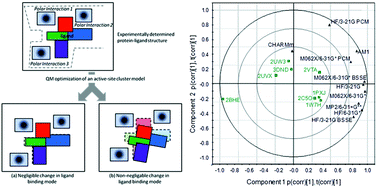Evaluating the enthalpic contribution to ligand binding using QM calculations: effect of methodology on geometries and interaction energies†
Abstract
As a result of research on

Maintenance work is planned for Wednesday 1st May 2024 from 9:00am to 11:00am (BST).
During this time, the performance of our website may be affected - searches may run slowly and some pages may be temporarily unavailable. If this happens, please try refreshing your web browser or try waiting two to three minutes before trying again.
We apologise for any inconvenience this might cause and thank you for your patience.
* Corresponding authors
a Department of Chemistry, Faculty of Science, King Mongkut's Institute of Technology Ladkrabang, Bangkok 10520, Thailand
b
Heptares Therapeutics, BioPark, Broadwater Road, Welwyn Garden City, Herts, United Kingdom
E-mail:
ben.tehan@heptares.com
Tel: +44-1707-358646
c
Department of Chemistry, Faculty of Science, Kasetsart University, 50 Phaholyothin Rd, Chatuchak, Bangkok 10900, Thailand
E-mail:
paul.gleeson@ku.ac.th
Fax: +66-2-5793955
Tel: +66-2-562-5555 extn 2210
d Department of Chemistry, Faculty of Science, and Center for Advanced Studies in Nanotechnology and its Applications in Chemical, Food and Agricultural Industries, Kasetsart University, Bangkok 10900, Thailand
As a result of research on

 Please wait while we load your content...
Something went wrong. Try again?
Please wait while we load your content...
Something went wrong. Try again?
D. Gleeson, B. Tehan, M. P. Gleeson and J. Limtrakul, Org. Biomol. Chem., 2012, 10, 7053 DOI: 10.1039/C2OB25657F
To request permission to reproduce material from this article, please go to the Copyright Clearance Center request page.
If you are an author contributing to an RSC publication, you do not need to request permission provided correct acknowledgement is given.
If you are the author of this article, you do not need to request permission to reproduce figures and diagrams provided correct acknowledgement is given. If you want to reproduce the whole article in a third-party publication (excluding your thesis/dissertation for which permission is not required) please go to the Copyright Clearance Center request page.
Read more about how to correctly acknowledge RSC content.
 Fetching data from CrossRef.
Fetching data from CrossRef.
This may take some time to load.
Loading related content
